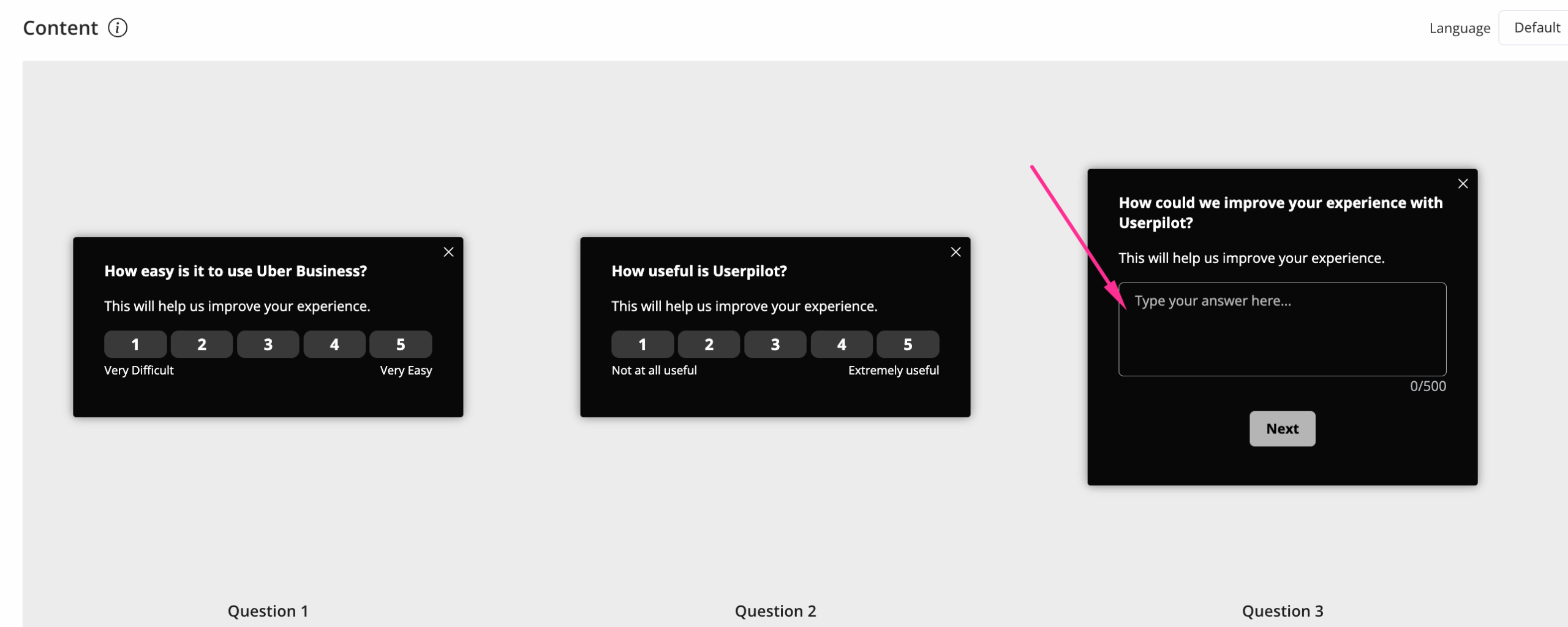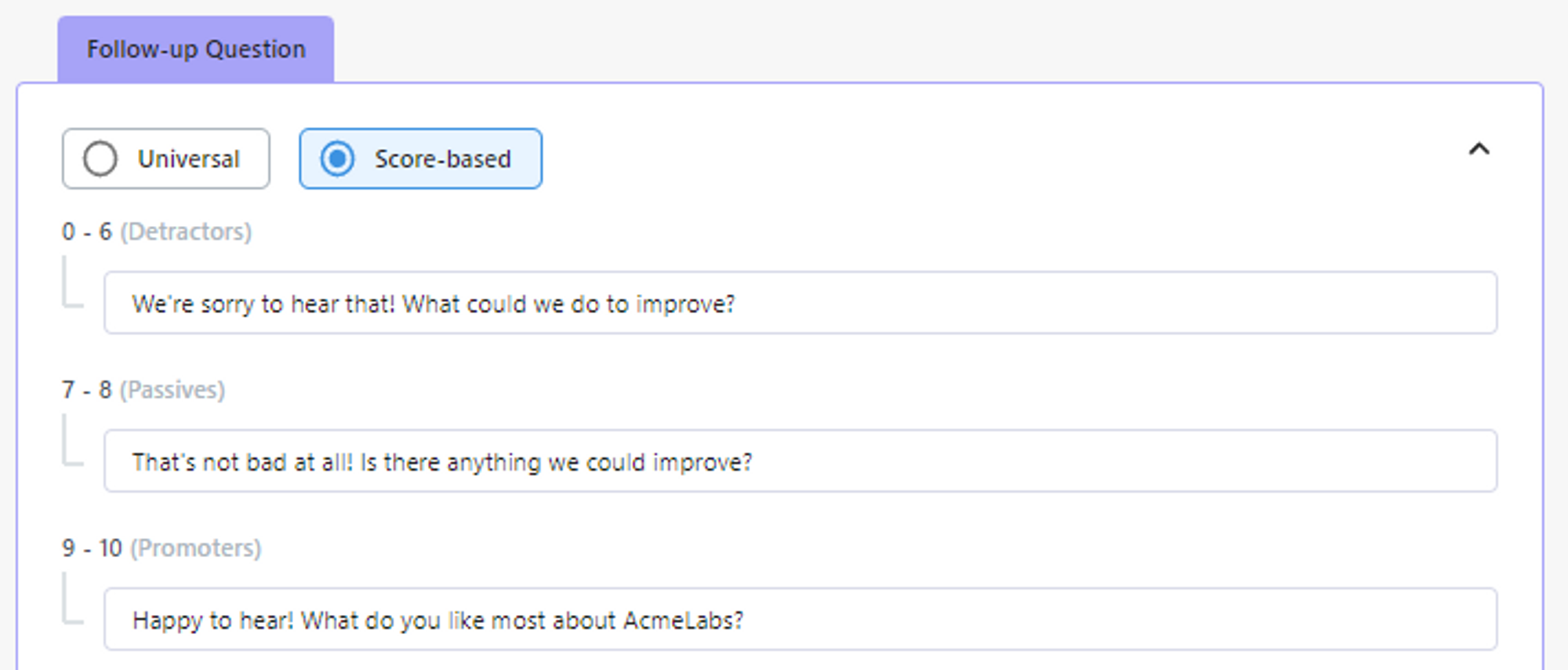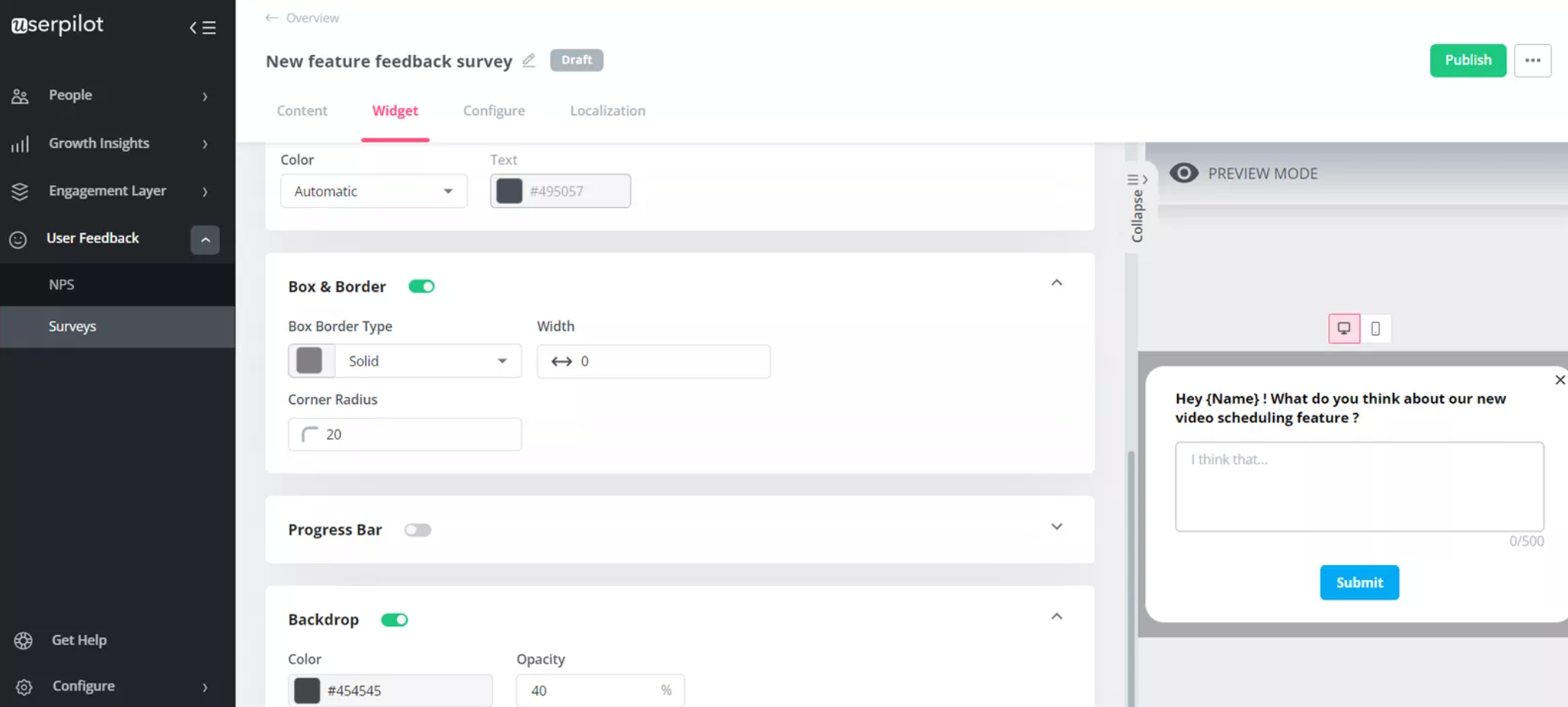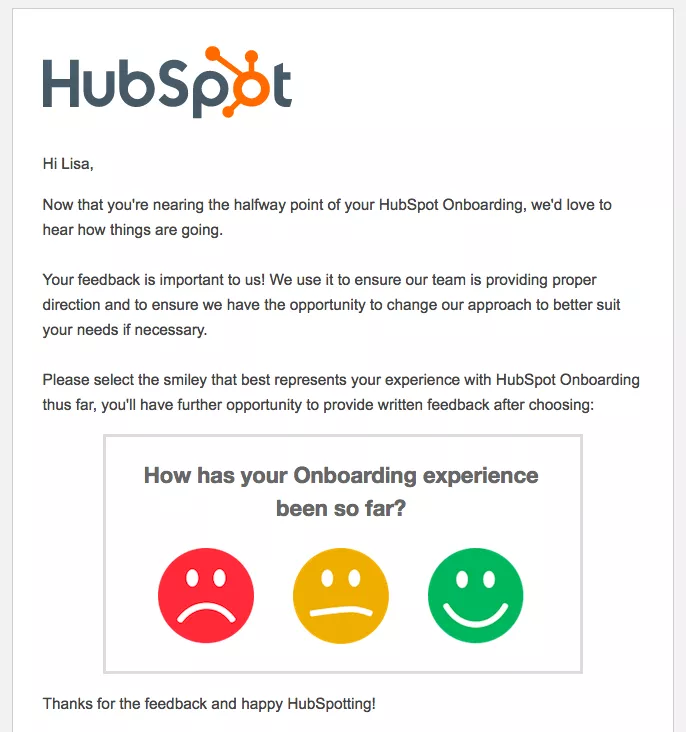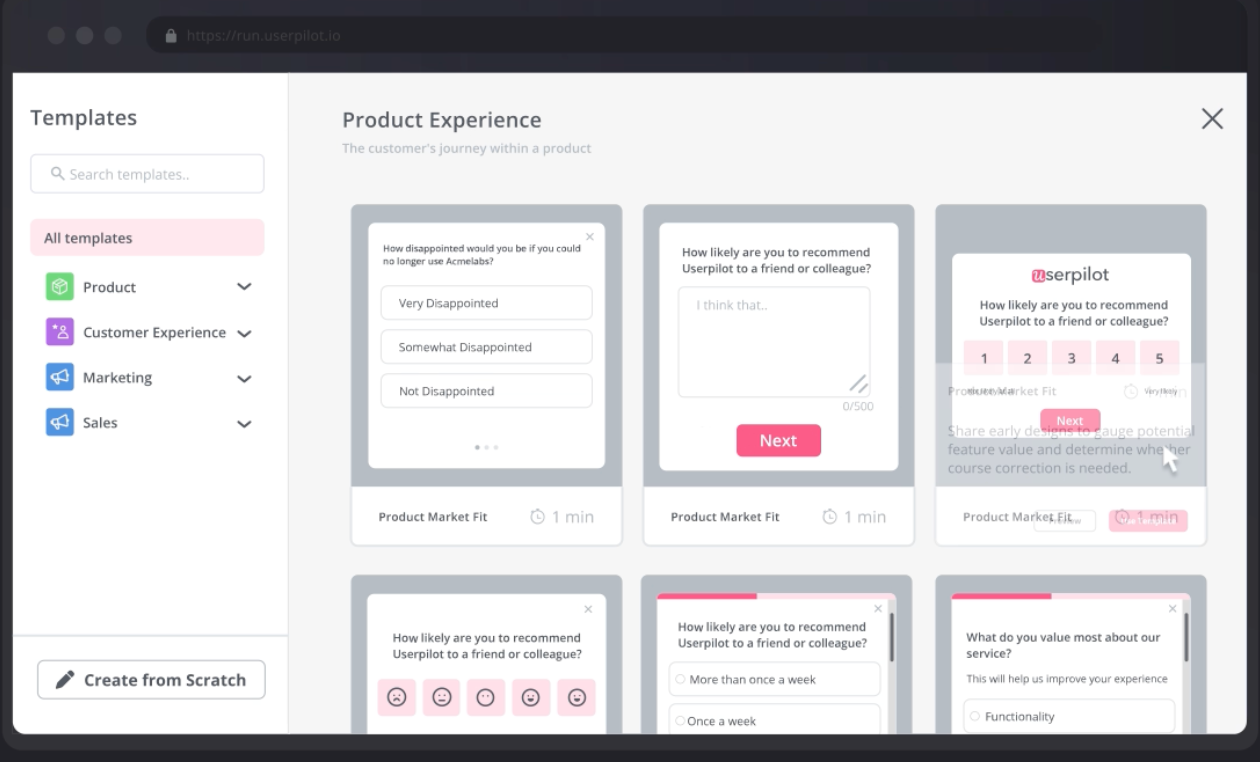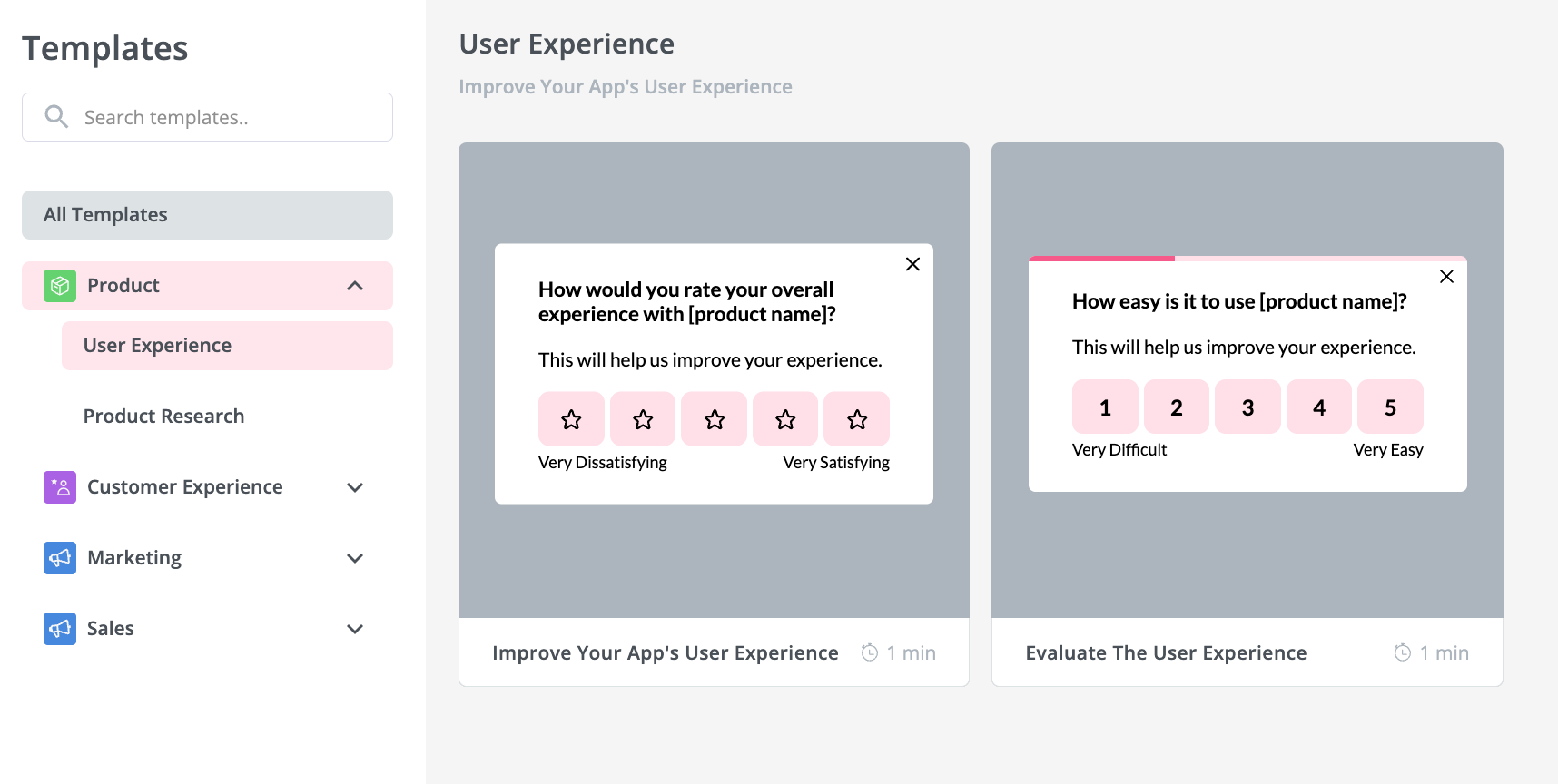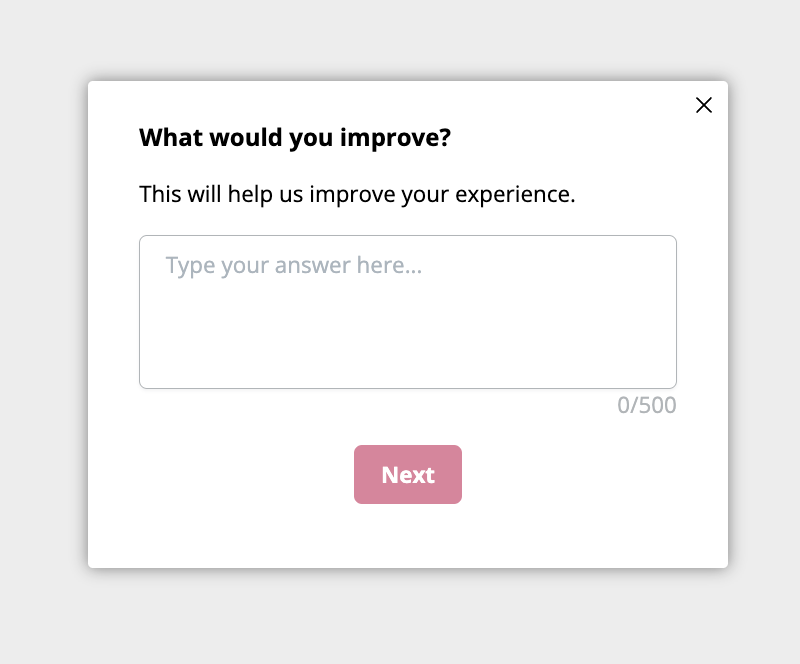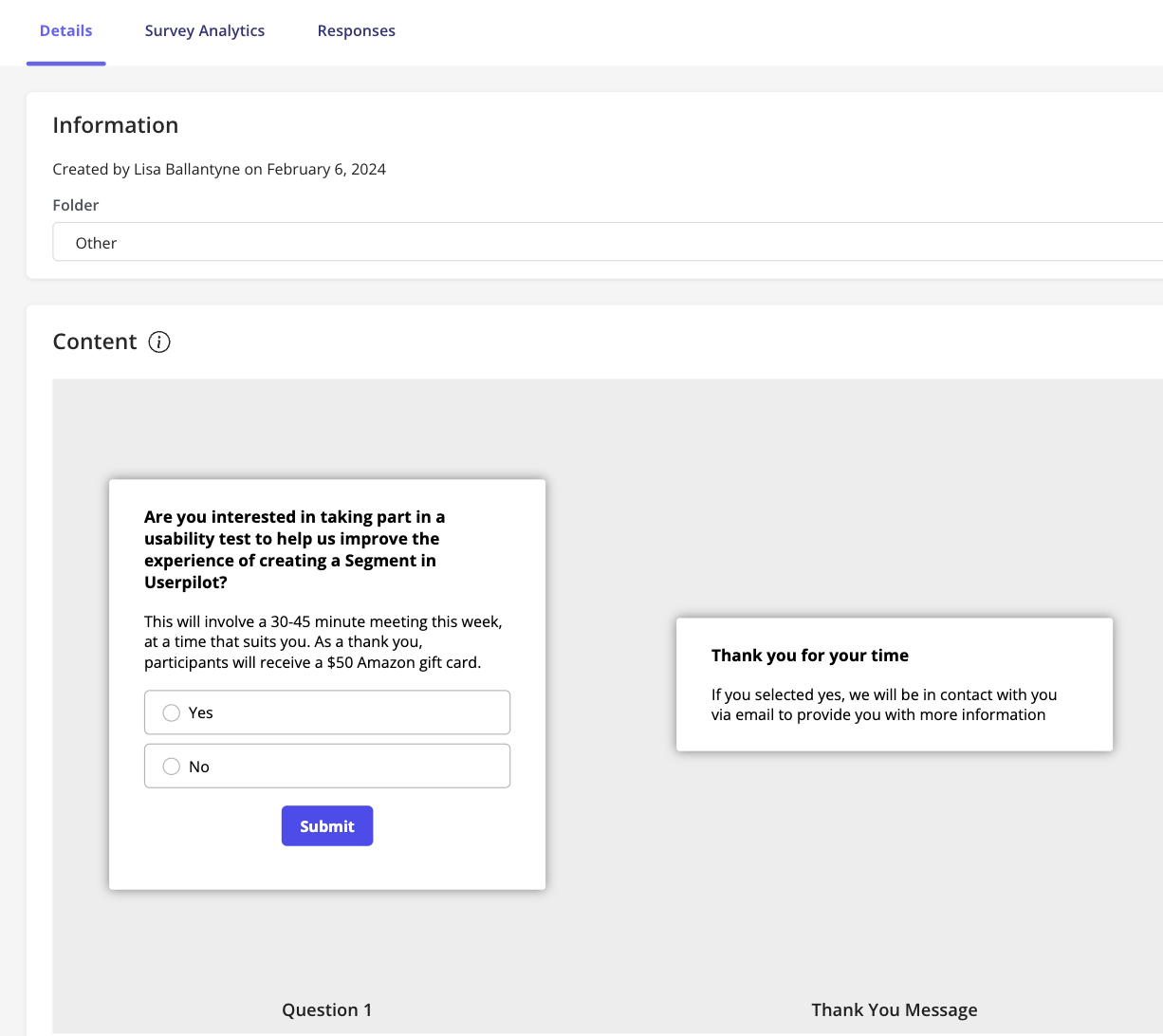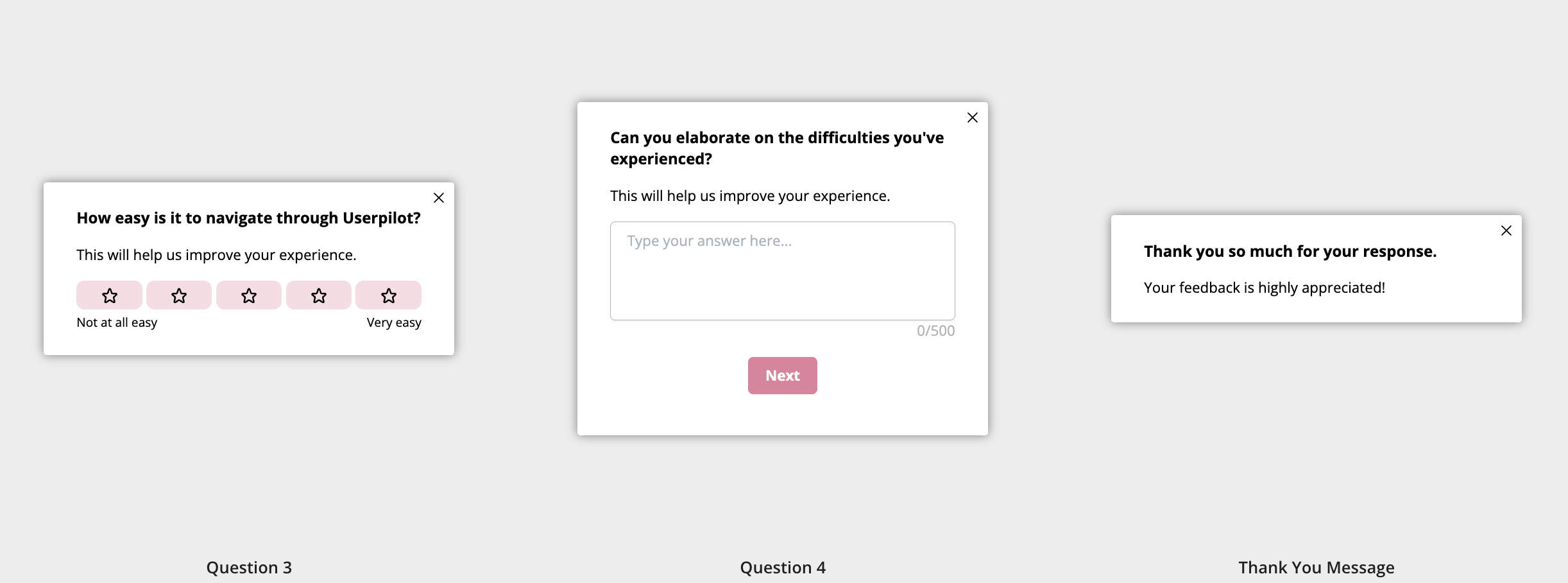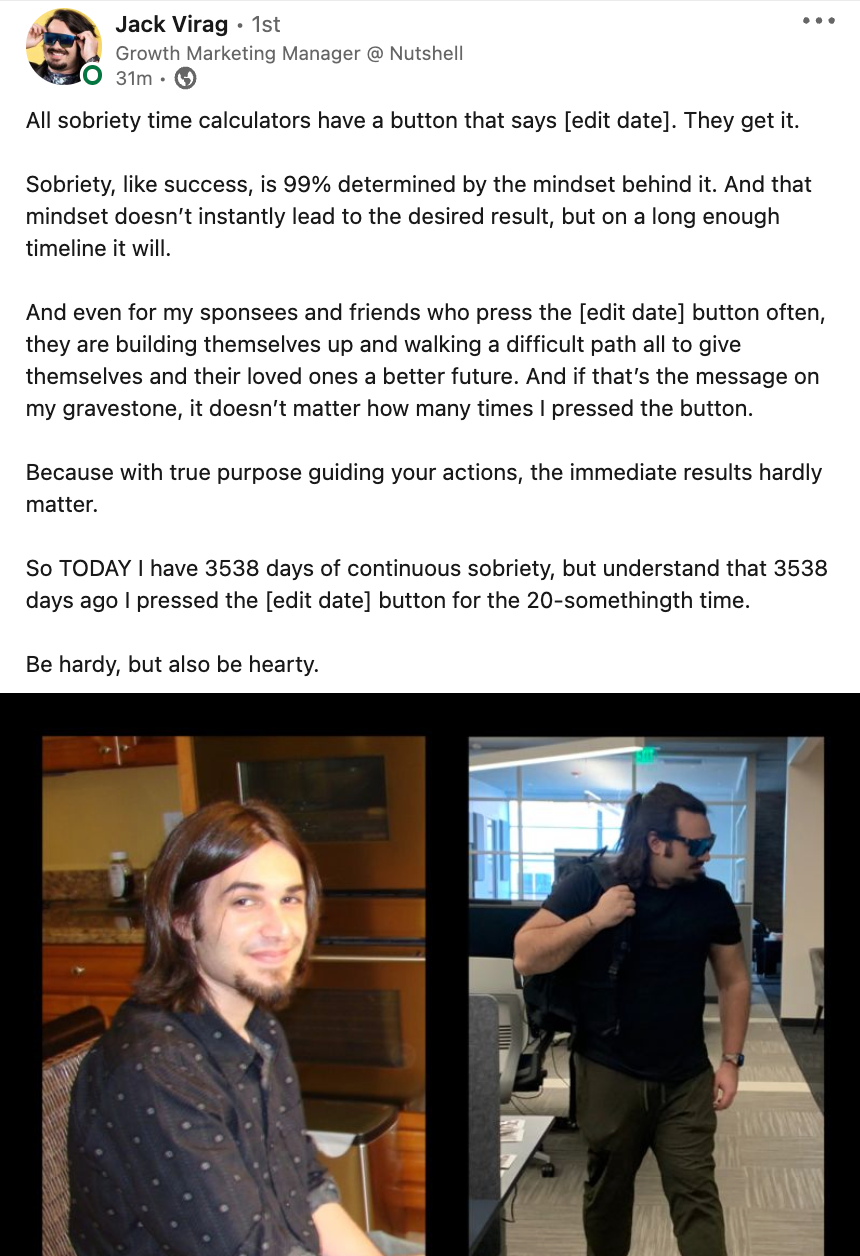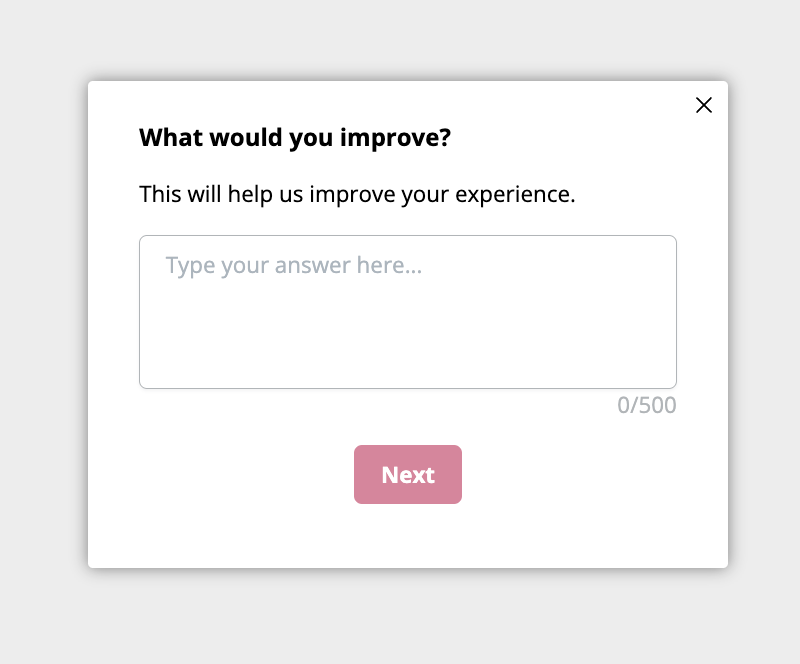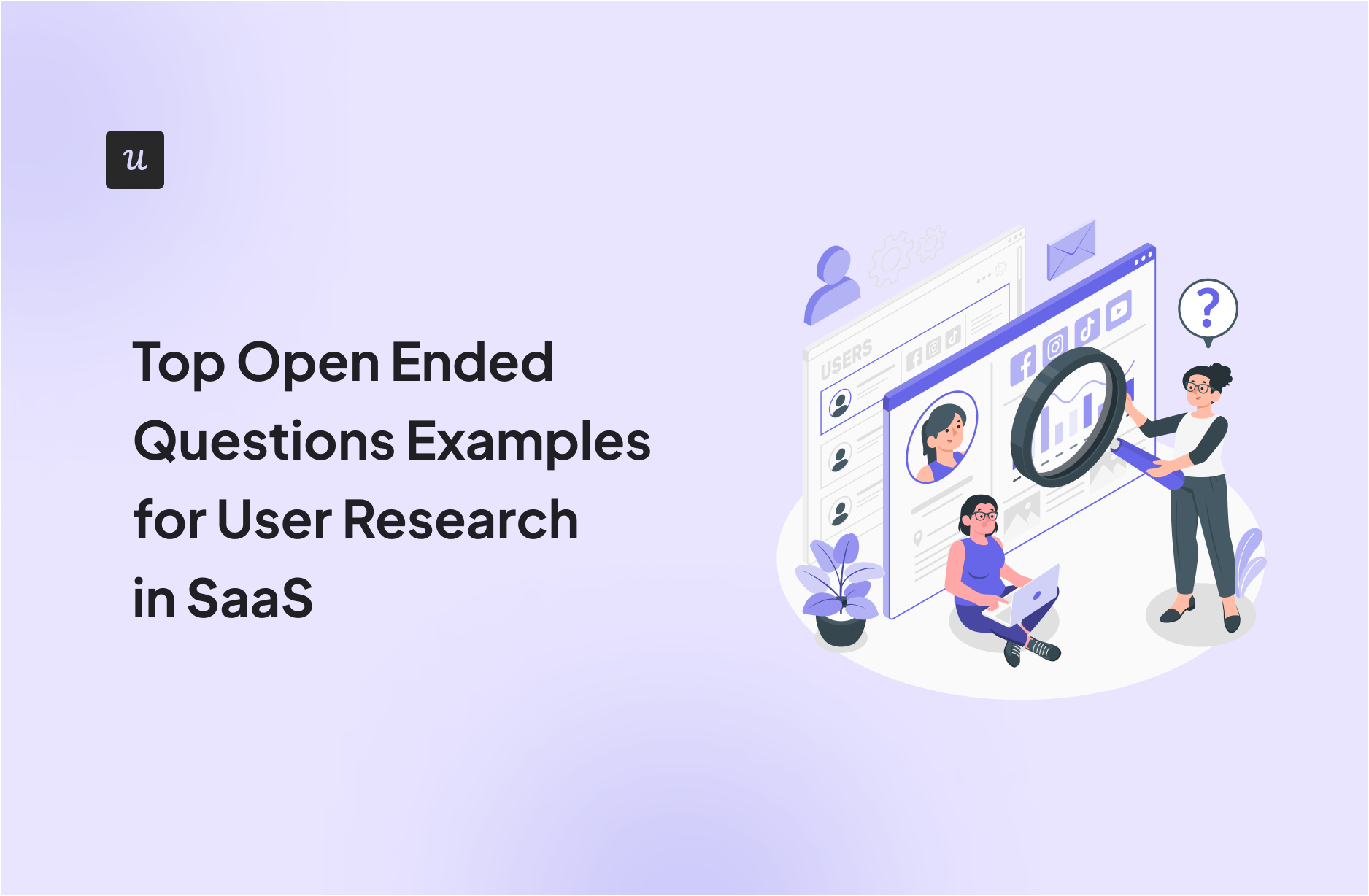
If you’re seeking open-ended questions examples that elicit meaningful insights, this guide is tailored for you. We cut straight to practical, usable examples you can immediately incorporate into your user research or interviews. Learn not only what powerful open-ended questions look like but also the key strategies behind crafting them. Ready to transform your dialogues into discovery-driven conversations? Let’s get started.
What’s your biggest challenge when asking users questions?
How do you currently try to understand your users’ needs?
What is your primary goal for improving your user research with open-ended questions?
You’re ready to unlock deeper user insights.
Stop guessing and start understanding. Userpilot helps you ask the right open-ended questions at the right time, directly within your app, to get the actionable insights you need to grow.
Try Userpilot Now
See Why 1,000+ Teams Choose Userpilot

Exploring the power of open-ended questions
Open-ended questions are a key to unlocking a deeper understanding and uncovering new insights. They diverge from the simplicity of yes-or-no answers, encouraging respondents to share more intricate thoughts and emotions. These questions allow respondents to answer in their own language, significantly contributing to the richness of data. This richness captures genuine sentiments and perspectives, offering SaaS businesses a deeper understanding of their audience’s needs and thoughts. Some examples of open-ended questions include:
- “Can you tell me more about your experience with our product?”
- “What challenges have you faced in implementing our software?”
- “How do you envision our product helping your business in the future?”
By incorporating open-ended questions into your surveys or interviews, you can gather valuable insights and feedback from your audience, effectively gathering insights.
Qualitative data fetched from open-ended questions encapsulate emotions, opinions, and ideas. By stimulating engaging, confiding, and multidimensional conversations, they transform simple dialogues into truly meaningful interactions. This power of open-ended questions is paramount in various contexts, such as classroom discussions and brainstorming sessions, and especially in SaaS user research where gathering intricate insights into user experiences is of utmost importance.
By encouraging respondents to answer freely, open-ended questions can provide insights that are often missed by closed-ended questions with predetermined answers. Respondents are not limited to selecting from multiple-choice questions but are encouraged to express their thoughts in their own words. This freedom leads to detailed responses that provide valuable insights into a certain topic, be it in a survey, a meeting, or a one-on-one conversation. Some advantages of using open-ended questions include:
- Allowing respondents to provide more detailed and nuanced answers – like with this NPS follow-up survey:
- Uncovering unexpected insights and perspectives.
- Allowing for more creativity and individual expression.
- Providing a more accurate representation of respondents’ thoughts and feelings.
Open-ended questions can be a powerful tool for gathering rich and meaningful data.
Crafting questions that encourage detailed responses
Crafting effective open-ended questions is an art that requires strategic thinking. The goal is to encourage respondents to provide full, detailed answers. This can be achieved by starting questions with ‘Why?’, ‘How?’, and ‘What?’, avoiding yes/no traps and using follow-up questions wisely.
Let’s delve into each of these strategies.
Start with ‘How’, ‘What’, or ‘Why’
Starting open-ended questions with ‘How’, ‘What’, or ‘Why’ leads to more thoughtful answers, fostering a deeper understanding. ‘What’ questions are particularly effective as they are usually impartial and encourage the sharing of personal thoughts and feelings. This strategy prompts respondents to move beyond a single-word answer, inspiring them to delve deeper into their thoughts and experiences.
Avoiding yes/no traps
Transitioning from closed to open-ended questions is a vital step in inviting elaboration and fostering genuine dialogue. Incorporating ‘why’, ‘how’, and ‘what’ into inquiries effectively facilitates this transition. Open-ended questions reflect the interviewer’s sincere desire to listen and learn, signifying a nonjudgmental and open approach to the conversation.
This approach discourages simple ‘yes or no’ responses, such as “strongly disagree,” encouraging respondents to provide more detailed responses.
Using follow-up questions wisely
While it’s essential to ask open-ended questions, it’s equally important to use follow-up questions wisely. If a closed-ended question is asked, it can be expanded by following up with an open-ended question for further details. For example, if a respondent provides a one-word answer to a close-ended question, a good open-ended follow-up question could be, “Can you describe why you feel that way?” This approach allows for a deeper dive into the respondent’s thoughts and experiences.
Further, follow-up questions should be focused on specific aspects of a topic and provide a clear context for effectiveness.
Using the right tools
Creating in-app surveys isn’t possible without the right tools.
Userpilot enhances user research in SaaS environments by enabling the creation of customizable, in-app surveys targeted to specific user segments. With over 30 templates and the ability to trigger surveys based on particular in-app events, Userpilot facilitates timely and relevant feedback collection. Its robust analytics tools help analyze diverse user responses, assisting in identifying trends and user needs.
This targeted approach allows SaaS companies to gather actionable insights efficiently, driving product development and improving user satisfaction by addressing specific user experiences and expectations.
Open-ended questions in different contexts
Open-ended questions can be a powerful tool in various contexts, such as user research, feedback surveys, and one-on-one conversations. They foster a culture of open communication and continuous learning. Ensuring a supportive environment for respondents, especially in team meetings and brainstorming sessions, is crucial for encouraging open and honest responses.
Let’s delve deeper into these contexts.
Open-ended questions for user research
Open-ended questions in user research help uncover detailed insights and foster engagement. They encourage participants to share their experiences and reasoning in detail, allowing them to choose what information to convey and how extensively they want to elaborate. This in-depth exploration of user experiences is far more valuable than a simple yes or no response.
For instance, a typical open-ended question in user research might request a walk-through of a participant’s typical day or inquire about their last interaction with a website. User interviews often use open-ended questions to prompt participants to recount stories, which can reveal their behaviors, motivations, and preferences.
When conducting usability tests, open-ended questions can be used during and after tasks to understand the participant’s thought process and feelings about the experience. The use of open-ended questions in user research can lead to the discovery of:
- Unexpected insights.
- Revealing mental models.
- Problem-solving strategies.
- Concerns that were previously unknown to researchers.
In user feedback surveys
User feedback surveys greatly benefit from open-ended questions. These questions are instrumental in gathering rich insights from customers, allowing them to express concerns openly and aiding in improving user experience. By asking open-ended questions, customers provide customer feedback in their own words, which offers a more authentic perspective and facilitates a deeper understanding of their views.
Specific open-ended questions such as ‘What did you appreciate most about your interaction with our team?’ and ‘How would you describe your overall satisfaction with our service?’ help in understanding customer satisfaction and tailoring services to meet their needs. Additional probing questions like ‘What were the key factors that influenced your satisfaction with our service?’ or ‘How does our customer service compare to others you have experienced?’ provide a broader industry perspective.
Creative inquiries such as describing the product using analogies and asking for specific improvement suggestions can enhance the feedback’s detail and creativity. Positioning open-ended questions at the end of a survey gives respondents the opportunity to voice additional thoughts and opinions beyond the scope of predefined answers.
During one-on-one conversations
In one-on-one settings, open-ended questions foster deeper conversations and allow individuals to express detailed opinions and experiences, building trust. For example, asking an individual about their personal motivations, like their reasons for dedication to work or potential reasons for considering leaving the job, can provide a wealth of insights.
Using open-ended questions during one-on-one conversations can uncover an individual’s personal motivations, help address any concerns or issues they might be facing, and demonstrate genuine interest in their well-being.
Enhancing learning opportunities at user interviews with open-ended questions
Open-ended questions can significantly enhance learning opportunities in various settings, such as product roadmap discussions and professional development workshops. They facilitate a valuable learning experience for both the interviewer and the interviewee by promoting conversation and providing diverse insights.
Let’s examine these contexts in detail.
Product roadmap discussions
In product roadmap discussions, open-ended questions encourage a conversational approach, inviting participants to share individual perspectives that cannot be captured with one-word answers. By using open-ended questions that start with ‘why’, ‘how’, and ‘what if?’, participants can explore topics in greater depth than with closed-ended questions. This depth of exploration fosters a thorough understanding of various perspectives, ultimately leading to a more comprehensive and inclusive product roadmap. Some examples of open-ended questions to ask in product roadmap discussions include:
- Why do you think this feature is important for our users?
- How do you envision this feature being implemented?
- What if we prioritize this feature over others, how do you think it will impact our roadmap?
By incorporating open-ended questions into your discussions, you can encourage more meaningful and insightful conversations that will help shape a successful product roadmap.
Strategic open-ended questions can guide stakeholders to articulate the value they perceive in the product roadmap process, reinforcing its significance in their minds. Some examples of these questions include:
- What are the company’s priorities for the upcoming year?
- Can you share any past experiences with similar problems?
- How do you envision this product roadmap helping you achieve your goals?
Asking these types of questions allows sales teams to offer solutions that avoid repeating previous failures and align with the organization’s goals.
Sales conversations can be transformed into collaborative strategy sessions by:
- Asking prospects to envision future success with the product or service.
- Identifying customer’s criteria for evaluating solutions.
- Adapting proposals to meet their requirements effectively.
Professional development workshops
Professional development workshops can greatly benefit from open-ended questions. These questions can enhance reflective thinking and potentially contribute to personal and professional growth. In these settings, open-ended questions encourage attendees to share their feelings and experiences, fostering a safe space for trust-building and genuine conversation.
When participants answer open-ended questions about future opportunities and challenges, it can open discussions about potential strategies and risk management in professional development contexts.
Leveraging open-ended questions for user insights
Open-ended questions provide a valuable tool for gathering user insights, guiding product development, and promoting a user-centered approach. Their ability to elicit detailed responses can reveal user needs, preferences, and potential issues – such as bugs or UX bottlenecks (see above).
Thus, these insights can enhance the product development process, making it more responsive to user needs and expectations.
Other uses of open-ended questions in SaaS companies
Open-ended questions have diverse applications in SaaS companies beyond user research. They can be used in sales to uncover customer needs and in company surveys to gather employee feedback. In each of these contexts, open-ended questions lead to more detailed responses, offering a deeper understanding of the situation at hand.
Sales questions to uncover needs
In the realm of sales, open-ended questions prove to be a powerful tool. They allow sales professionals to:
- Uncover the specific problems that customers are trying to solve.
- Understand the customer’s goals and needs.
- Tailor their messaging to prospects, showing how the offered solution aligns with their goals.
By understanding the customer’s perspective, the sales team can effectively communicate the value of their product or service to potential customers.
Sales representatives should pose tailored questions for different situations. For instance, asking vehicle prospects about their preferences or environmental concerns related to SUV emissions, and real estate agents asking homeowners about their selling needs. Understanding customer concerns or barriers that almost prevented them from taking action can be achieved by specifically asking about these issues through open-ended questions.
After a customer responds to a closed-ended question, asking open-ended questions allows sales teams to explore the ‘why’ behind their initial response, gaining deeper insight into customer motivations.
Company surveys for employee feedback
Company surveys are another area where open-ended questions can provide immense value. These surveys can include open-ended questions to gather in-depth feedback from employees, providing insights into their satisfaction and perceptions of the workplace. For instance, open-ended questions can invite employees to describe the company or their job using metaphors, thereby offering a richer understanding of their actual feelings and perceptions.
Company surveys can also include questions that invite employees to share the challenges and weaknesses they perceive in their teams. Employers can inquire about what changes employees would like to see in the organization, offering insights into potential areas for improvement. Inquiries about the impact of not addressing key challenges can highlight the urgency of certain issues within the company. These open-ended questions, thus, form an essential part of employee feedback, providing a deeper understanding of their experiences, challenges, and expectations.
Navigating difficult topics with open-ended questions
Navigating difficult topics with open-ended questions requires a neutral, empathetic approach. Utilizing neutral, open-ended questions focused on positive outcomes and solutions is essential in addressing sensitive issues. A collaborative and empathetic approach, avoiding any imposition or dictation, aids in handling tough conversations with respect. This approach encourages constructive dialogues rather than confrontational queries.
Compassionate language and open-ended questions signal a willingness to understand rather than judge, fostering a safer environment for sensitive topics. For instance, asking questions like ‘What challenges did you face?’ or ‘What can we learn from this?’ can facilitate a more open and respectful conversation. When crafting open-ended questions, considering cultural sensitivity and communication styles is important to ensure the questions are respectful and effective. However, ‘why’ questions, while open-ended, might elicit defensive responses and should be used cautiously in sensitive situations.
Open-ended questions as a tool for building trust
Open-ended questions serve as a powerful tool for building trust. They initiate meaningful conversations with clients, paving the way for establishing trust. Active listening and responding with empathy when following up on open-ended questions are crucial practices for showing understanding and building rapport with clients. A genuine dialogue is supported when conversational techniques are balanced, allowing clients to lead the conversation and ensuring responses are respectful of the client’s autonomy.
By employing open-ended questions designed to understand the client’s specific situation, goals, and challenges, clients feel encouraged to express their thoughts and contribute actively to the conversation.
Maximizing survey efficacy with open-ended questions
Maximizing survey efficacy involves balancing the use of open and closed-ended questions. To prevent survey fatigue and maintain high response rates, open-ended questions should be used sparingly and strategically, focusing on questions that yield direct insights.
This balance ensures that the survey is comprehensive yet not overwhelming for the respondents.
Balancing quantity and quality
Balancing the quantity and quality of questions is crucial in survey design. Mixing close-ended and open-ended questions effectively prevents making surveys long and tedious, which can lead to lower response rates. The aim is to elicit detailed and meaningful answers without overwhelming the respondents with too many questions.
When to use open-ended vs. close-ended questions
Choosing between open and closed-ended questions depends on the desired type of data and analysis. Close-ended questions should be asked when the objective is to collect responses that can be quantitatively analyzed, such as plotting data on graphs or identifying trends and percentages. On the other hand, open-ended questions are ideal when seeking to understand participants’ opinions, feelings, or general thoughts. Using a mix of both open and closed-ended questions can create a more detailed feedback picture.
Best practices for formulating open-ended questions
Formulating open-ended questions effectively requires strategic thinking. To foster a broad spectrum of responses, closed-ended questions should be reworded into open-ended formats. Clear and focused open-ended questions prevent irrelevant responses and guide respondents to supply detailed and relevant answers.
Further, these questions should be straightforward and free from industry-specific jargon to ensure comprehensibility for all respondents.
Conclusion
In conclusion, open-ended questions play a vital role in various contexts, particularly in SaaS user research. Their ability to elicit detailed responses provides a wealth of insights into user perceptions, preferences, and experiences. This wealth of insights can:
- Guide product development.
- Enhance user satisfaction and loyalty.
- Build trust.
- Foster an open communication culture.
Open-ended questions provide the tools to unlock deeper understanding, uncover new insights, and transform simple dialogues into truly meaningful interactions. By effectively crafting these questions and strategically using them in various contexts, businesses can gather valuable feedback, enhance learning opportunities, and navigate difficult topics.
Therefore, understanding and leveraging the power of open-ended questions is crucial for any business aiming to deepen their understanding of their users, and continuously improve their products and services.
To sum up, open-ended questions are a powerful tool that can significantly enhance user research in the SaaS industry. They encourage detailed responses, uncover deeper insights, facilitate meaningful conversations, and foster a culture of open communication. By balancing the use of open and closed-ended questions, understanding when to use each type, and crafting questions effectively, businesses can maximize survey efficacy and gather valuable feedback. This feedback can guide product development, improve user experience, build trust, and ultimately, lead to enhanced user satisfaction and loyalty.
Frequently asked questions
What is the value of open-ended questions in user research?
Open-ended questions in user research are valuable because they allow participants to share detailed experiences and reasoning, leading to rich and valuable feedback. This can provide comprehensive insights into user perspectives.
How can open-ended questions enhance learning opportunities?
Open-ended questions can enhance learning opportunities by promoting conversation and providing diverse insights for both the interviewer and interviewee.
How can open-ended questions be used in sales?
Open-ended questions in sales can be used to uncover customers’ specific problems and tailor messaging to align with their goals, leading to better sales outcomes.
What are the best practices for formulating open-ended questions?
When formulating open-ended questions, it’s essential to reword closed-ended questions, keep the questions clear and focused, and avoid industry-specific jargon to ensure comprehensibility for all respondents. This helps to foster a broad range of detailed and relevant responses.
How can open-ended questions be used to navigate difficult topics?
Using a neutral and empathetic approach with open-ended questions can help navigate difficult topics by focusing on positive outcomes and solutions while respecting the sensitivity of the issue and ensuring a collaborative dialogue.

